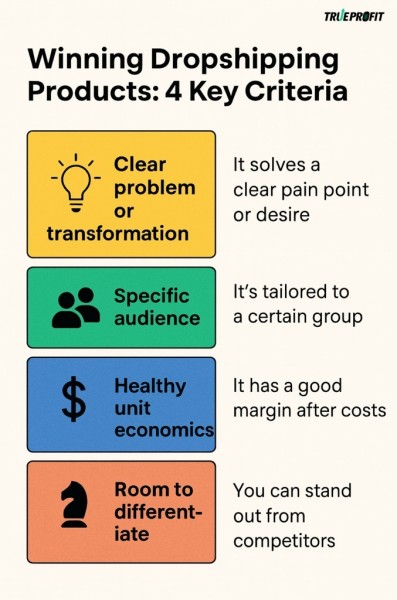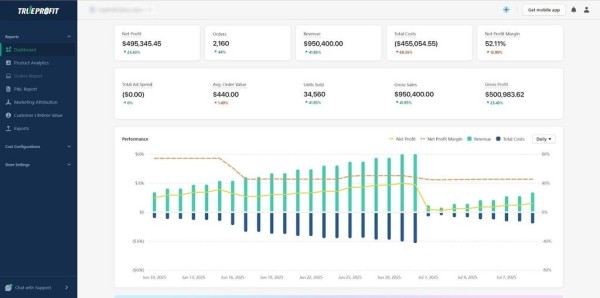
Search “winning dropshipping products” and you’ll see the same patterns everywhere: viral TikToks, “copy this product” YouTube videos, and screenshots of revenue with no context.
What you don’t see:
- How many of those “winners” lose money after ad costs.
- How quickly copycats pile in and crush margins.
- How many beginners never learn a system—so they just chase the next product list.
In 2026, the dropshipping market is still big and growing, but competition is smarter. A real winning product is no longer “something that sells for a week.” It’s a product that solves a clear problem for a specific customer, at a price and cost structure that leaves you real profit after shipping and ads.
This guide breaks down a practical, step-by-step way to find winning dropshipping products, and shows how to use curated resources and other data instead of guessing.
What counts as a “winning” dropshipping product now?
For a lot of beginners, “winning product” just means “I saw a TikTok about it.” That’s not enough anymore.
In 2026, a genuine winning dropshipping product usually has four traits working together:
- Clear problem or transformation: It fixes something annoying (mess, pain, wasted time) or creates a visible upgrade (better sleep, calmer pet, more organized room). Vague “cool gadgets” rarely last.
- Specific audience: “Pet owners” is too broad. “New apartment dog owners who work from home” is specific. The more clearly you can picture your customer, the easier it is to find and convert them.
- Healthy unit economics: After supplier cost, shipping, transaction fees, discounts, and ad spend, there is still enough profit per order to make the product worth pushing. Revenue without margin is just an expensive vanity.
- Room to differentiate: You can position the product differently, bundle it smarter, improve the offer, or explain it better than generic listings. If the only edge is “slightly cheaper,” you’ll always be vulnerable.

Keep these criteria in mind as a checklist. A product idea that only hits one or two of them might work for a spike. A long-term winner tends to tick all four.
Start with people and problems (not supplier catalogs)
Most failed stores follow this pattern: Open a supplier app → Scroll until something looks cool → Import it and hope.
A better approach is to start with real people and their daily frustrations, then work backward into product ideas.
Think about:
- Who you actually understand (or can research deeply): Remote workers, students in dorms, new parents, apartment dog owners, small business owners, hobby creators, etc.
- What those people complain about regularly: Clutter, boredom, pain, time pressure, stress, lack of space, low motivation.
For each customer group, write a few “problem → desired outcome” statements. For example:
- Remote workers → stiff neck and back → want a simple setup that feels ergonomic and focused.
- Apartment dog owners → bored dog destroying furniture → want a calmer, stimulated dog so they can work in peace.
- Parents in small homes → toys everywhere → want quick, kid-friendly storage so rooms look tidy again.
Only after you’ve done this should you start mapping possible product types:
- Ergonomic stands, risers, and posture supports.
- Enrichment toys, feeders, and boredom-buster kits.
- Foldable organizers, stackable storage, and clever baskets.
You can then cross-check these categories against real-world data, like TrueProfit’s breakdown of dropshipping products on Shopify, to see which kinds of items actually move on the platform and how your ideas might fit.
Use data to filter ideas (so you don’t fall in love too early)
Once you’ve got a handful of product directions, it’s time to see if the market cares. You don’t need expensive tools to start—just enough data to avoid obvious dead ends.
Look at:
- Search demand: Use tools like Google Keyword Planner, Ubersuggest, or Ahrefs to check whether people search for your product type and related problems. You’re looking for clusters of phrases like “best [product] for [audience]”, “how to fix [problem] at home”, “X for small spaces”, not just one keyword with random volume.
- Trend stability: Use Google Trends to see interest over the last 2–5 years. Steady or slowly rising is good; one giant spike followed by a flat line often means “trend is over.”
- Social proof of interest: Search TikTok, Instagram Reels, and YouTube for problem-focused terms (for example, “dog bored at home”, “small desk setup”, “toy storage hack”). Check:
- Are there multiple creators consistently making content in this space?
- Do videos have meaningful comments from people with the same problem?
- Are there things people keep asking for that current products don’t fully solve?
You’re not trying to “prove” your idea will work. You’re trying to filter out ideas where nobody seems to care, and focus on problems that clearly have ongoing attention.
Study competition to find gaps, not to copy
The presence of competitors usually means there’s money in the niche. The trick is to understand how they’re competing.
For each potential product, search it on: Google (organic and Shopping), Amazon or niche stores you find through product names, hashtags, and ads
Then, for the main players, ask:
- What’s their angle: Are they selling a cheap gadget, a lifestyle upgrade, a premium solution, or a problem-solver? What’s the promise in their headline?
- How do reviews look: Look beyond the star rating. What specific pains and delights show up in text reviews? Are customers complaining about shipping times, confusing instructions, poor durability, or missing accessories?
- What’s happening in the ad libraries: Use Meta Ads Library or TikTok’s Creative Center to see how others are promoting similar products. Are they running fresh creatives, or the same tired angle for months?
Your goal is to spot opportunities where you can:
- Explain the product better.
- Show it in a more relatable context.
- Bundle it in a way that solves the problem more completely.
- Serve a sub-niche the big stores treat as an afterthought.
That’s where differentiation—and real winners—come from.
Check the profit math before you get excited
This is where a lot of “winning products” quietly stop being winners.
You can have a product that looks great in a TikTok, gets clicks, and even gets sales—but still loses money once you subtract ad spend, shipping, fees and refunds. To avoid that, you need a simple but honest way to do the profit math before you commit to scaling.
Instead of juggling exports and calculators, you see immediately whether a product that “looks good” on revenue is actually profitable once all costs are included. That turns the profit math from a manual chore into a live scoreboard you can use to decide what to kill, keep or scale.
Even with a tool, you should still understand the basics. For each product idea, estimate:
- Selling price (what the customer pays)
- COGS (what your supplier charges you)
- Shipping you pay (if any)
- Payment fees (Stripe/Shopify Payments, PayPal, etc.)
- Average ad cost per order (based on realistic CPC and conversion, not wishful thinking)
Then calculate:
Net profit per product = Selling price – (COGS + shipping + fees + ad cost + other variable costs)
If you plug in realistic numbers and only end up with a small amount of net profit per product before overhead(apps, tools, staff, taxes), that product will be very hard to scale safely—even if it gets lots of clicks and sales.
Rather than forcing thin-margin products to work, steer your research toward dropshipping products with high profit margin – categories and offers where, after TrueProfit (or your own math) absorbs all costs, there’s still enough left to make growth actually worth it.
Turn good candidates into real offers
A product idea only becomes a winning product once a real offer converts real traffic.
For each shortlisted product, create a simple, focused offer:
- A clear headline that states who it’s for and what it changes in their life.
- Honest photos and, ideally, short videos showing it in use in a real home or workspace.
- Transparent shipping and return information so expectations are set up front.
- A price and bundle structure that makes sense with your profit calculations.
You don’t need a huge catalog. In many cases, it’s better to launch with one to three strong offers that all support the same audience and problem set, instead of ten random products with no narrative.
Once your pages are live, run small, controlled traffic tests (for example, on Meta or TikTok) to see:
- Are people clicking your ads at a reasonable rate?
- Do they view content, add to cart, and initiate checkout?
- Do enough of them actually buy to make the numbers work?
At this stage, your goal isn’t “scale to the moon.” It’s “see which ideas deserve a second round of iteration.”
Track performance and profit, not just sales
The final piece of finding winning dropshipping products is ongoing tracking. A product that works today can stop working tomorrow if ad costs jump, shipping changes, or competitors flood the space.
Keep an eye on:
- Conversion rate on your product page.
- Cost per purchase from paid channels.
- Refunds and returns (and the reasons behind them).
- Net profit per store, per product, per campaign and per order—not just revenue and ROAS.
This is where many stores that look successful from the outside quietly die. They keep scaling anything that brings in revenue, never realizing some of those “winners” are only winning for the supplier and the ad platforms.
By contrast, stores that last review product performance with a profit lens. They:
- Cut “fake winners” that bring volume but not profit.
- Double down on products that stay profitable as they scale.
- Use what they learn to choose future products with similar economics and customer response.
At a very early stage, you can start with a spreadsheet. But as soon as you’re testing multiple products and campaigns, that approach becomes fragile and time-consuming. This is exactly where a profit-first tool like TrueProfit comes in - a Net Profit Analytics platform built for Shopify merchants and dropshippers that:
- Pulls in your revenue, refunds, discounts and taxes directly from your store.
- Lets you define COGS and shipping rules per product, variant or country so your cost side is accurate.
- Syncs live ad spend from channels like Facebook, Google and TikTok so you’re not guessing your marketing cost per order.
- Combines everything into real-time net profit and profit margin at the store, product and campaign level.

Use curated lists as inputs, not scripts
There’s nothing wrong with using product lists and examples—as long as you treat them as inputs to your process, not scripts to follow blindly.
The key is to plug any idea you find into your own framework:
Customer → problem → outcome → product type → demand check → profit check → test → track → iterate
Do that consistently, and “finding winning dropshipping products” stops being about chasing the latest viral list. It becomes a skill you can use in 2026 and beyond—no matter how the trend cycles change.





